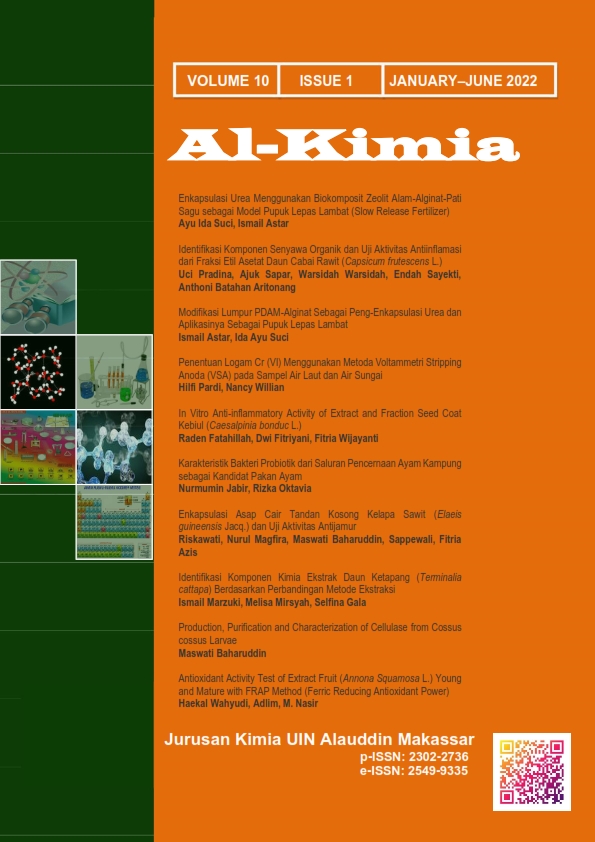Uji Aktivitas Antioksidan Ekstrak Buah Srikaya (Annona Squamosa L.) Muda dan Matang dengan Metode FRAP (Ferric Reducing Antioxidant Power)
Abstrak
The antioxidant activity test of young and ripe Srikaya fruit extract (Annona Squamosa L.) had been carried out by using the FRAP (Ferric Reducing Antioxidant Power) method. This study aims to determine the antioxidant activity of young and ripe srikaya fruit extract using the FRAP method by using qualitative and quantitative method. The research method used was FRAP (Ferric Reducing Antioxidant Power) which was based on a reduction reaction in an acid state towards a yellow Fe3+ (Potassium hexacyanoferat(III)) complex compound to become a bluish-green Fe2+ complex compound due to electron donors from antioxidant compounds. The result of the qualitative analysis of the antioxidant activity of young and ripe srikaya fruit extract was a change in color in the sample extracts of young and ripe Srikaya fruit due to the reduction reaction in an acid state towards the yellow-colored Fe3+ (Potassium hexacyanoferat(III)) complex compound to become a bluish-green Fe2+ complex compound. due to electron donor of antioxidant compounds. Quantitatively, the average antioxidant activity of samples of young and ripe srikaya fruit extract was respectively 7,448 mgAAE/g extract and 9,351 mgAAE/g extract. The result indicated that the antioxidant activity of ripe srikaya fruit was greater than that of young fruit. Based on the results of the analysis parameter testing the t-test, it can be concluded that there is a significant difference in the antioxidant activity of the young and ripe srikaya fruit extract (Annona squamosa L.).
The antioxidant activity test of young and ripe Srikaya fruit extract (Annona Squamosa L.) had been carried out by using the FRAP (Ferric Reducing Antioxidant Power) method. This study aims to determine the antioxidant activity of young and ripe srikaya fruit extract using the FRAP method by using qualitative and quantitative method. The research method used was FRAP (Ferric Reducing Antioxidant Power) which was based on a reduction reaction in an acid state towards a yellow Fe3+ (Potassium hexacyanoferat(III)) complex compound to become a bluish-green Fe2+ complex compound due to electron donors from antioxidant compounds. The result of the qualitative analysis of the antioxidant activity of young and ripe srikaya fruit extract was a change in color in the sample extracts of young and ripe Srikaya fruit due to the reduction reaction in an acid state towards the yellow-colored Fe3+ (Potassium hexacyanoferat(III)) complex compound to become a bluish-green Fe2+ complex compound. due to electron donor of antioxidant compounds. Quantitatively, the average antioxidant activity of samples of young and ripe srikaya fruit extract using the FRAP method was respectively 7,448 mgAAE/g extract and 9,351 mgAAE/g extract. The result indicated that the antioxidant activity of ripe srikaya fruit was greater than that of young fruit. Based on the results of the analysis parameter testing the t-test, it can be concluded that there is a significant difference in the antioxidant activity of the young and ripe srikaya fruit extract (Annona squamosa L.).
##plugins.generic.usageStats.downloads##
Authors who publish with this journal agree to the following terms:
1) Authors retain copyright and grant the journal right of first publication with the work simultaneously licensed under a Creative Commons Attribution License that allows others to share the work with an acknowledgement of the work's authorship and initial publication in this journal.
2) Authors are able to enter into separate, additional contractual arrangements for the non-exclusive distribution of the journal's published version of the work (e.g., post it to an institutional repository or publish it in a book), with an acknowledgement of its initial publication in this journal.
3)Authors are permitted and encouraged to post their work online (e.g., in institutional repositories or on their website) prior to and during the submission process, as it can lead to productive exchanges, as well as earlier and greater citation of published work (See The Effect of Open Access).


